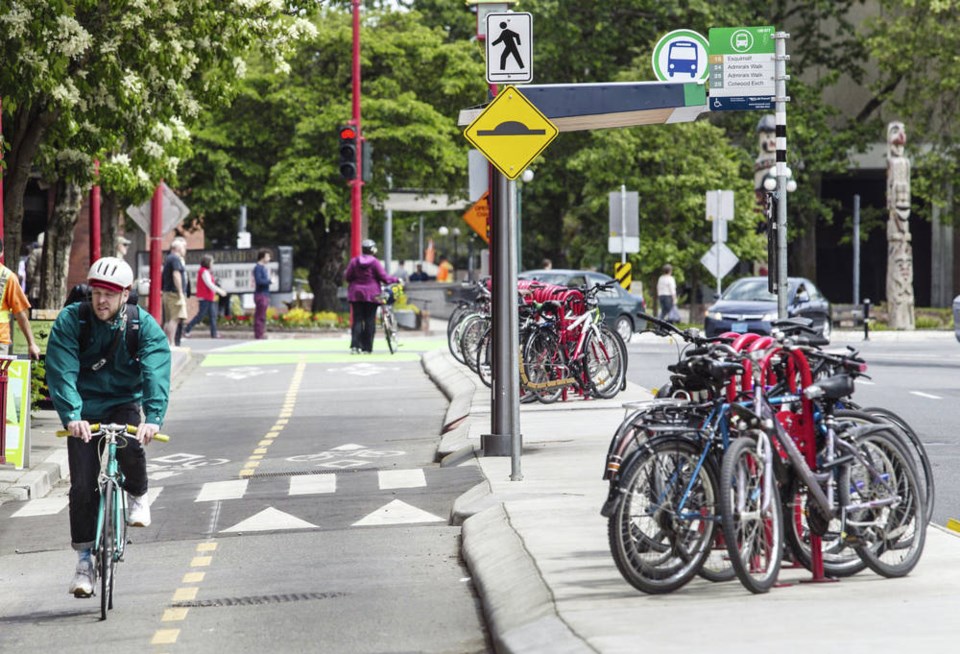The city’s design of protected bike lanes on Pandora Avenue and Wharf Street that separated bus stops from the sidewalk discriminates against pedestrians who are blind and visually impaired, says the B.C. Human Rights Tribunal.
When the city installed a two-way protected bike lane on the north side of Pandora Avenue in 2017, four bus stops were moved from the curb to an island on the road side of the bike lanes.
Pedestrians have to cross the bike lanes at painted crosswalks to reach the “floating” stops. The city added tactile markings on the ground to help those with vision impairments find the crosswalk. The opening of a protected bike lane on Wharf Street in August 2019 created a fifth “floating” bus stop.
Tribunal member Norman Trerise agreed with a human-rights complaint lodged against the city that the design was dangerous for people who are blind or have low vision trying to reach the five bus stops, because they can’t know if cyclists have stopped at the crosswalks.
In a decision that has broader implications for transportation planning in cities across the country, Trerise agreed with testimony from cycling and transportation experts that the city had followed international best practices for the bikeway design.
Signs near the bike lanes indicate to cyclists when they’re approaching a pedestrian crosswalk, and they’re expected to yield to pedestrians, but Trerise found “a significant minority” did not stop or slow down based on video footage that depicted 17 instances in which cyclists rode past the crosswalks while pedestrians were waiting to cross.
The tribunal heard from several people who are blind that they rely on their hearing to determine when it’s safe to cross, but the sound of an approaching bike is drowned out by the ambient noise on Pandora and Wharf.
Oriano Belusic, who initiated the complaint on behalf of the Canadian Federation of the Blind, described himself as a confident and independent traveller who uses a white cane or guide dog to navigate the city.
He said he doesn’t feel confident crossing the bike lanes to reach the bus stop without the help of a sighted person, “which significantly diminishes my freedom of movement and causes me a lot of worry, shame. I feel like a second-class citizen who does not deserve the same equal service the way sighted public does.”
His feelings were echoed by others. Mary Ellen Gabias, president of the Canadian Federation of the Blind, said she felt “frightened and anxious” trying to cross the lanes. She felt she had to shout loudly to indicate she was trying to cross and still couldn’t be sure it was safe.
“As a result she felt humiliated and undignified,” Trerise wrote in his decision.
Belusic said in an interview he was pleased that the tribunal decision acknowledged that the bikeway poses a problem for people who are blind.
“It’s a win because it acknowledges that discrimination has taken place,” he said.
In response to accessibility concerns, the city included pedestrian-activated flashing lights that produce an audible signal for pedestrians at the Wharf Street crosswalk when it opened in August 2019. The flashing lights indicate to cyclists they need to yield to a pedestrian trying to cross. It plans to install the signals on Pandora next year.
Trerise decided the city’s plan to install audible signals at the crosswalks is a reasonable accommodation, but he wrote the city is discriminating against people who are blind until audible signals are installed on Pandora.
Belusic said the audible signal falls short of solving the problem, because it doesn’t provide assurance that cyclists have stopped and it’s safe to cross.
“Hopefully engineers will put their minds to it and see what can be done to create a safe solution,” he said.
The tribunal heard many suggestions from Belusic and other witnesses to make the crosswalks safer, including moving the bike lanes to the south side of Pandora, turning the protected bike lanes back to painted lanes, and building an underpass or overpass.
Trerise wrote in his decision that the solutions presented by the complainant created undue hardship for the city, would create more dangerous cycling conditions, or were based on technology that is not available. He also noted the suggestions were not brought to the city when they “could have received proper consideration.”
Trerise wrote the city adopted its design in good faith after meaningful consultation with the cycling advocacy groups and an accessibility group, as well as offering open houses for the general public, but no advocacy group for the blind was consulted.
City spokesman Bill Eisenhauer said the city understands the accessibility concerns raised and is committed to balancing the needs of all vulnerable road users.
The city consulted several design guidelines that are relied upon by other municipalities in B.C., Canada and North America to create the protected bike lanes, none of which acknowledge the accessibility concerns raised in the human rights complaint, according to Trerise’s decision.
“I think that that the ruling speaks to something that the B.C. Human Rights Tribunal has seen as a gap in those design guidelines,” Eisenhauer said.
Similar designs of protected bike lanes and bus stops exist in Saanich, Vancouver and Ottawa, he said.
Going forward, Victoria plans to include audible signals on all crosswalks that connect to “floating” bus stops, he said, and the city is open to other options as they become available. The city also plans to continue educational efforts to ensure cyclists know they need to yield to pedestrians at the crosswalks.
Eisenhauer said it’s a good idea for cyclists to make eye contact with pedestrians or let them know that it’s safe to cross.
“Make contact either visually, or through your voice to say, ‘Hey, good to go,’” he said.
regan-elliott@timescolonist.com



